-
solutinos
-
Hire
Frontend Developer
Backend Developer
-
NodeJS Developer
-
Java Developer
-
Django Developer
-
Spring Boot Developer
-
Python Developer
-
Golang Developer
-
Ruby on Rails Developer
-
Laravel Developer
-
.NET Developer
Technology
-
Flutter Developer
-
React Native Developer
-
Xamarin Developer
-
Kotlin Developer
-
Cross-Platform Developer
-
Swift Developer
-
MongoDB Developer
-
C Developer
-
Smart Contract Developers
Cloud
-
-
Services
Mobile Development
Web Development
- Work
-
Multi Services App
-
Food Delivery App
-
Grocery Delivery App
-
Taxi Cab Booking App
-
Multi Services App
-
OTT Platform APP
-
Social Media APP
-
Freelance Service App
-
Car Rental App
-
Medicine Delivery App
-
Liquor Delivery App
-
Sports Betting App
-
Online Coupon App
-
eLearning App
-
Logistics & Transportation App
-
Courier Delivery App
-
On-Demand Real Estate App
-
E-Wallet APP
-
Online Dating App
-
Handyman Services App
-
-
Process
-
Company
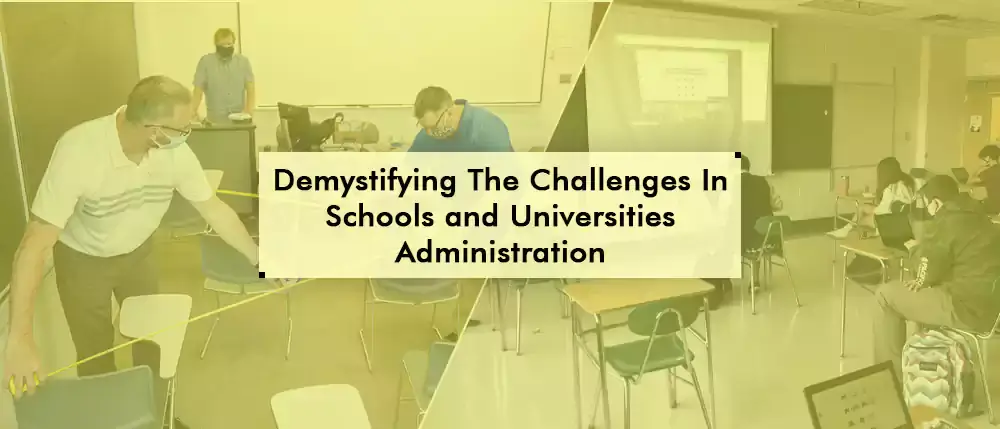
For learning and education to be perpetual, the associated mediums, channels, avenues and sources need to be perpetual and maintained at optimum levels as well. Unfortunately, that is where a major chunk of challenges in the education sector lies. Several schools, colleges, universities and educational institutions still use age-old and obsolete mechanisms and teaching methodologies to impart knowledge.
The testing processes are manual, curriculum is irrelevant, applied knowledge is relatively low and more. So, what can such institutions do to ensure students get the best of education and knowledge? Can technology play a crucial role in eliminating some of the most excruciating barriers that prove expensive to not just institutions but students as well?
Well, the good news is technology can revolutionize tons of aspects in the education sector, paving the way for optimized learning and excellence.
And this is what we are going to analyse, understand and explore in today’s post of our Digital Transformation in The Education Sector Series guide. We will identify the plaguing concerns in education today and look at the simplest solutions to them through tech implementation.
So, what are we waiting for? Let’s get started.
Some Important Statistics on Education and Learning
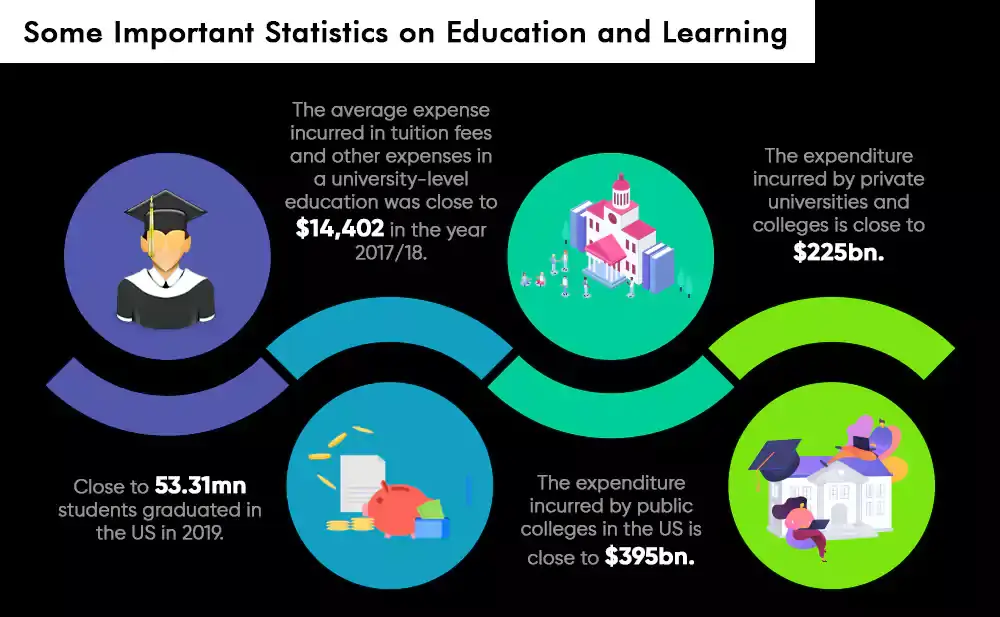
- Close to 53.31mn students graduated in the US in 2019.
- The average expense incurred in tuition fees and other expenses in a university-level education was close to $14,402 in the year 2017/18.
- The expenditure incurred by public colleges in the US is close to $395bn.
- The expenditure incurred by private universities and colleges is close to $225bn.
Challenges Involved In Running an Education Institution
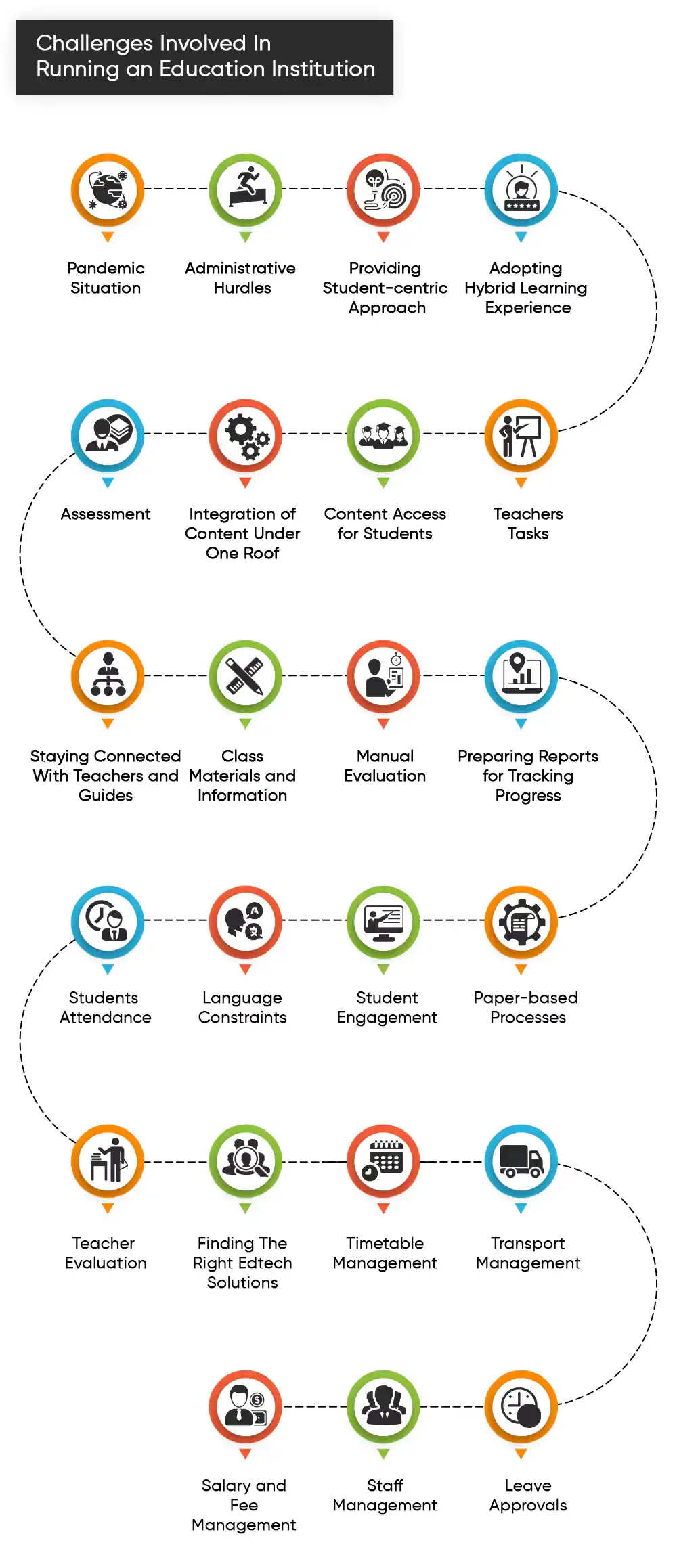
From our extensive research and analyses, we have identified and curated close to 23 challenges in the education sector. These challenges have not only stemmed out of demanding situations like the recent pandemic but from the continuous usage of age-old teaching and administrative mechanisms as well.
Let’s individually look at what the challenges are.
Pandemic Situation
The recent outbreak of the Covid-19 virus has been devastating. Over the last few months, we’ve been hearing news and updates about the mental and physical health conditions of people from across the world, businesses being shut down, lockdown restrictions, protocols and more. But what we’ve been hearing less about is the impact the pandemic situation had on education and schools.
With the abrupt onset, several schools, universities and colleges shut down their classes interrupting learning across all age groups. Students have been asked to attend classes virtually from home through basic technology such as messengers, emails and laptops.
But there’s another catch here. The impact the pandemic had on students who had access to the internet and technology was comparatively less than it had on students who did not have access to anything. For those students to whom schools and classrooms were the only sources of education, the pandemic completely disconnected them from learning.
According to UNESCO reports, around 1.26bn children across the globe have had their education interrupted because of the pandemic. This is close to 70% of the children population. In simple words, the pandemic has cost some students a year in their academic journey and their entire association with learning and education for the rest.
Administrative Hurdles
Educational institutions have tons of administration hurdles with respect to the enrolment of students, management of courses, evaluation of teachers, revenue generation and management, budgeting and fund allocation, academic milestones and achievements, classroom and facilities management, student monitoring, pedagogy and more. With institutions still implementing obsolete technologies – or no technology at all – these hurdles end up as burdens on the shoulders of administrators.
If you notice, most of the challenges are redundant tasks that are just an automation away from autonomous functioning.
Providing Student-centric Approach
Teaching methodologies today are curriculum-centric. This means that institutions have curriculum and academic goals at the fulcrum of learning and education. Because of this approach, there is a stark difference between what students learn from their textbooks and what is required in the real world. There is also a difference between their interests and strengths and what is expected out of them academically. This causes a disconnect between theoretical knowledge and practical knowledge.
Besides, the current education system also considers every student as the same with similar learning curves, experiences, knowledge assimilation capabilities and more. But in reality, every student is different. With no personalized learning and education in place, there is zero student-centric approach, resulting in a division between students.
Adopting Hybrid Learning Experience
Hybrid learning is of recent origin that offers the best of both worlds – technology and offline education - to students. Several institutions have their own definition of hybrid learning, where some offer both virtual and offline classes, some provide digital mediums of learning such as apps or portals and others simply bring in interactive whiteboards and more into their classrooms.
But these are implementations happening in urban regions. Places where education should matter still have outdated mechanisms and merely textbook-based teaching. There is hardly any immersive or interactive learning happening in such classrooms.
Assessment
Assessments are what test a student’s capabilities in terms of what has been taught, what has been understood and how much they can apply their understanding to solving real-world problems. But assessments in institutions are still linear with rigid practices and metrics. Rote learning is evident in major countries, with institutions suppressing creativity, imagination and expression of understanding. Assessments are also redundant and time-consuming from an administrative perspective with teachers having to manually set evaluation questions and work on them for grading students’ performances.
Integration of Content Under One Roof
Educational materials, course modules, reference papers, books and content are all over the place today. A student has to carry diverse books and resources to their institutions, which are still offline. This means for all the subjects they learn, individual resources have to be carried. When the need to refer to topics arises, they have to explore multiple resources and books to seek information they need. This makes them spend more time on accessing content than learning it.
Teachers Tasks
Teachers have tons of redundant tasks to perform every single day. This could be their administrative tasks such as punching in their attendance or setting their schedule for portions or performing student or classroom-specific tasks such as taking attendance, developing timetables, referring materials to conduct classes, bringing in variations in their teaching processes, managing multiple subjects/grades and more. On any given day, teachers perform more time on redundant tasks than working on making learning and education more enriching.
Staying Connected With Teachers and Guides
The association of students with their teachers and guides is only till the school is in operation for the day. Once the final bell is called and students leave the premises, there is no way they could get in touch with their teachers to get their questions clarified. They either have to wait until the next day to find solutions to their doubts or get them solved by someone else. This disconnect further pushes their time required for a student to understand a topic or concept.
Class Materials and Information
Announcements of news and information or issuance of circulars are common in schools and institutions. However, all such announcements and updates are manually circulated to individual classrooms through teachers. Offline systems are used for the sharing of information that could range from anything between upcoming holidays to assessment timetables. Because of this, not only is time wasted on a redundant task but spaces for errors are created as well. And if a student is on leave on that particular day, retrieving information from a credible source becomes challenging, too. Need Help
Manual Evaluation
With no digital solutions in place, teachers still have to manually evaluate student assessments. For a class of 25 students in the US or close to 45 in third-world countries, students have to individually go through evaluation papers, find errors, appreciate the right application of concepts, compare growth and progress, offer feedback and encourage students to keep going.
The intensity of difficulties increases when the teacher manages multiple classrooms or grades with them having to repeat the processes all over again. The key takeaway here is that such burden on teachers also deprives them of individual care and attention students need for their actual growth.
Preparing Reports for Tracking Progress
The assessment papers of students are data. The analysis of it is information. But information without visual representation is futile. No inference or understanding could be figured out from basic information. That’s when teachers have to prepare reports for evaluation papers and present information in a visualized form for the understanding of parents. Compiling information from multiple sources, teachers have to look into the progress of each student and manually offer insights on what has to be done to make learning more impactful.
Students Attendance
The process of taking student attendance is still manual in several institutions and universities. A solid time of around ten minutes is spent on taking attendance, reducing the time for teaching to less than 30 minutes on an average. This cumulatively numbers to an hour for one teacher for one week. Besides, offline attendance systems are also prone to several modifications and manipulations. They are vulnerable to losses as well with no backup available in case something goes wrong. With these challenges, it becomes tough for teachers to keep track of students who consistently take leaves in an academic year.
Language Constraints
Language is a major constraint when it comes to imparting education. A classroom is one of the most diverse environments with students from multiple ethnicities and diversities coming together for one common cause – learning. But today’s language constraints pose additional concerns in the lives of such students. A student who has difficulty understanding a local language, it becomes difficult for them to understand what is being taught, what is in the textbook and what needs to be written. With textbooks and materials also in that particular language, understanding and assimilation is almost zero for several students. This also impacts their interaction with their classmates.
Student Engagement
Classrooms are predominantly linear today with teachers and educators doing most of the talking and students being passive throughout sessions. For teaching and understanding to be effective, there needs to be a balance of interactions, which is completely absent today. Students are passive participators in learning and there are hardly any group activities involved. Concepts like collaborative learning are alien even today. Because of very less engagement, it becomes increasingly difficult for teachers to get their students’ attention and retain them for long. There is an immense dip in curiosity and interest in students with them zoning out most of the time.
Paper-based Processes
Right from the time a student approaches an institution for admission till progress cards are issued, all the tasks in the chain are paper-based. Evaluations are on paper, assessment questions are presented on paper, attendance is taken on paper-based journals and more. Not just that, papers are used for administrative processes in institutions as well.
This not only makes the maintenance of crucial data difficult but makes it challenging to archive them for future purposes as well. From unnecessary physical space to lack of outcomes, paper-based processes are only hurdles in institution administration.
Teacher Evaluation
Teachers need to be constantly evaluated to ensure students get the best of learning experience. The more qualified a teacher is, the more impactful the teaching will be. But in reality, teacher evaluation is a myth in several institutions across the globe. Tons of teachers and educators are redundant in terms of their skill sets. They are unable to use tech devices without training. And to be blunt, a lot of subject-matter teachers don’t share insights or talk about topics outside of their expertise because of lack of exposure. If only teacher evaluation mechanisms were in place, all the loopholes could be fixed for optimized teaching.
Finding The Right Edtech Solutions
For a lot of school administrators, implementing edtech solutions is hardly driven by a purpose. In most cases, it is to remain in trend or because their competing schools or institutions have installed the latest gadgets in their classrooms. But merely installing edtech solutions won’t get the job done, would it?
It’s a very purpose-driven process where tons of factors have to be considered before finding vendors and installing one. When teachers are underprepared to use edtech solutions, this exercise is futile. When there is inconsistent internet connectivity, it becomes pointless again. When edtech solutions are implemented without adequate reasoning, it simply becomes another facility in the premises and not a teaching medium.
Timetable Management
Timetable is the way through which teachers and administrators come up with tasks and schedules for a given point of time. However, timetables are mostly done on journals or paper today and stuck on bulletins. This removes aspects for revisits, modifications, collaborations and more. Offline ways of timetable development also don’t give adequate information on the scope of schedules such as estimate time to complete portions, topics coverage, learning outcomes and more.
Transport Management
This is a standalone module in several institutions that administrators take care of apart from their other tasks. For an institution located outside city limits, transportation becomes inevitable and it is on administrators to find ideal vendors for student and teacher commute. Besides, they have to maintain good rapport with them, work on invoicing and payments, maintain the vehicle, look into its maintenance and expenses on servicing, manage transport timetables, counter escalations and do more. With so much happening, most of the processes go manually with no digital record whatsoever.
Salary and Fee Management
Revenue and expenses management are two crucial responsibilities of administrators. On one side, they have to keep track of funding, fund allocation, fees payments from students and more and on the other side, they need to ensure teachers are paid on time, their extra hours are calculated and included in their salaries, payouts to housekeeping and facilities management teams, transportation drivers, materials vendors and more. Transactions happen on a daily basis in institutions and without a proper tracking system in place, this is often haywire.
Staff Management
An ideal student-teacher ratio is anywhere between 1:10 to 1:40. But in several institutions, this goes beyond 40. What’s more concerning is that one teacher also teaches multiple subjects to overcome staffing issues. Staff management is indeed a hurdle as administrators have to ensure the right ratio is maintained for optimum learning, adequate workforce is deployed for administrative and facilities management services and more. With offline systems, there is no analytics or mechanisms to gather insights on staff management hurdles and shortcomings, resulting in the lack of an idea of how this could impact teaching, learning and the future.
Leave Approvals
Students are not the only ones who take leaves, staff and teachers require leaves, too. Even today, a lot of leave application processes are verbal or through offline mediums such as letters or journal entries. A lack of tracking and maintenance mechanism causes confusions in timetable development and management and in the calculation of salary for payouts. Because they are offline, several leave applications are overlooked and teachers have to manually remind stakeholders for the approval of leaves. And because of last-minute approvals, it becomes difficult for administrators to look for backup or substitute teachers to engage classrooms.
How Can Bringing In Modern Tech Solutions Solve The Challenges?
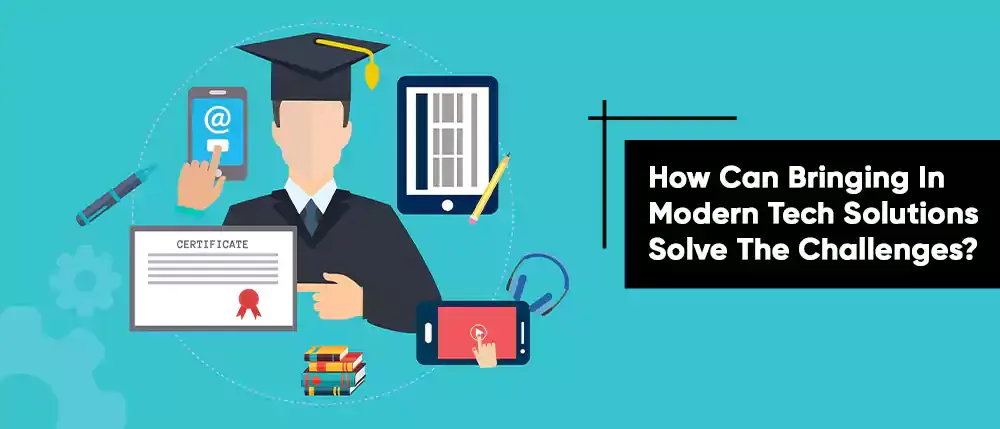
If you notice, the challenges we discussed are prevalent not only in aspects relating to the delivery of education but in administration and management aspects as well. Standalone bubbles of processes exist in the current education scenario, making it difficult for stakeholders to come together at any given point of time.
However, these challenges could be fixed through simple tech implementations. Let’s look at what the solutions are.
Educational Platforms
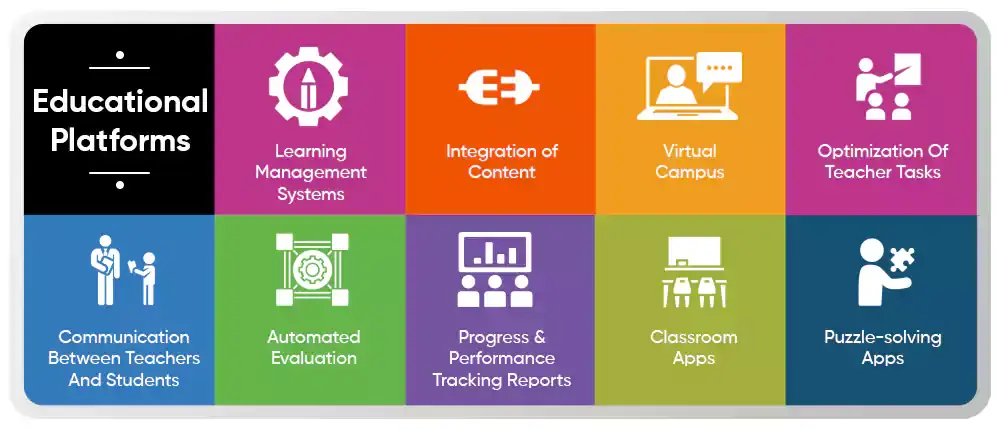
An educational platform is a broad, umbrella term for a myriad of possibilities and solutions that can be brought into an institution. In simple words, educational platforms solve concerns in the following aspects.
Learning Management Systems
A holistic, consolidated system that blends teaching and administrative practices and aspects. From the teaching side, learning management systems offer a unanimous learning portal for all students, content integration, attendance marking systems, evaluation and assessment modules, visualizations of progress and more.
From an administrative perspective, it offers a simplified solution to track and maintain teacher attendance, performance, coordination between institution vendors, invoicing, payroll management, content upgrades, facilities management, teacher training and more.
The best part about learning management systems is that it is a single portal that is implemented throughout an institution. Stakeholders have to simply log in and access their respective modules. A lot of overlapping and interoperable features to streamline processes exist as well. For instance, a teacher can instantly apply for leave through this portal which goes as a triggered email or task to the respective stakeholder.
Integration of Content
Content from multiple resources, sources and materials can be integrated into an educational platform for the seamless access for students and teachers. With this integration, students can search, filter and sort for required content or topic and instantly get their questions answered. With content integration, information from third-party portals in the form of graphics, videos, animations and more can be integrated as well, paving the way for an immersive learning experience.
Virtual Campus
Virtual campuses might seem futuristic and all too technical but in reality, it’s one of the most efficient and realistic projects. Virtual campuses are online locations of universities or educational institutions, where students can log in to their respective portals and virtually attend classes, view recorded sessions, attend seminars, complete assignments, upload projects, take evaluation exams, download forms and do more. Through the use of virtual campuses, students can even go on a virtual tour in the premises and get to understand the history and heritage of their institutions.
Optimization Of Teacher Tasks
Administrators need not use obsolete techniques or tools to schedule their tasks to teachers and educators. With the help of scheduling apps, they can create tasks, assign tasks, involve stakeholders, review tasks, modify them, revisit and do more. In fact, they can also develop to-do lists, reminders, deadlines, progress trackers, goals, concerned points of contact and more to help teachers complete their tasks. Need help
Communication Between Teachers And Students
Educational platforms come with messenger or in-portal texting services that allow students to get in touch with their teachers to get their questions answered. With these communication channels, students can even note down their questions and compile them so they could get all of them cleared at once. With seamless integration, these answers and clarifications could be included in the student’s dashboard, notes or content section.
Automated Evaluation
Often, teachers conduct evaluations that do not necessarily require students to write elaborate answers. Concepts like multiple choice questions, true or false, or other Bloom’s Taxonomy assessment methodologies are included by teachers that do not demand extensive analysis. Such assessments and evaluations can be automated on these educational platforms, where algorithms at the backend can match questions with answers and grade students accordingly. A good chunk of hours can be saved on teachers’ time with this.
Progress and Performance Tracking Reports
With assessments and evaluation becoming digital, it is now simpler for teachers to visualize the information in hand about students. The tracking reports keep a consistent track of student performance and progress across topics and subjects and identify patterns for teachers to work on. For instance, teachers can know if a particular student is strong in math or the challenges, they face in learning history to take corresponding corrective measures. These digital reports can be easily shared for collaboration, analyses and archiving. And at any given point of time, performance for a specific duration can be compared.
Classroom Apps
Classroom apps are interactive solutions part of educational platforms. These might be as extensive and generic as video conferencing or note-taking apps or as creative as presentation and broadcasting apps. Every educational platform offers its own set of classroom apps designed to drive engagement in classrooms, increase attention spans and sustain interests among students.
Puzzle-solving Apps
Another layer to the classroom apps to sustain interests and participation among students is the puzzle-solving app. With this, students can apply what they learn across subjects in solving puzzles that mimic real-world concerns and problems. These puzzles could either be individualistic tasks or those that require collaborative team efforts. These apps help sharpen students’ minds, understand concepts better and prepare better for the real world. And let’s be honest, these are also fun and rewarding and encourage a competitive spirit.
Smart Classrooms
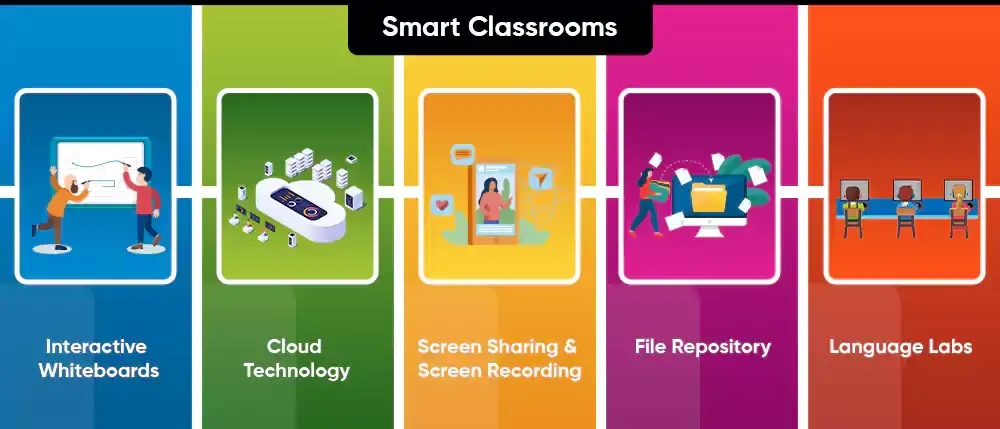
Edtech has not only evolved on the software side such as learning management systems and apps but on the hardware side as well. Peripheral devices in computing have been modified and adapted into diverse purposes to offer enriching teaching and learning experiences. Together, these infrastructures are called smart or virtual classrooms. Let’s look at what these classrooms are made up of.
Interactive Whiteboards
Interactive whiteboards are the modern-day boards but with a digital layer embedded in them. Sensors, cameras and an intuitive UI power these whiteboards that allow teachers to write on the wall or the board like they would do on a conventional board. But the magic is not how smooth the boards are but the allied features they bring to the table.
Once a teacher completes writing on the board, they can choose to erase through digital erasers if they like. Or, they could copy and share the notes with students, screengrab and add them as notes for students references, simultaneously pull out and show videos and graphics in real time, do a Google search and show instant results, draw perfect circles with tools, bring in charts and graphs and do more. These boards are perfect teaching companions equipping teachers with everything they need for seamless teaching.
Cloud Technology
Cloud technology powers smart classrooms by connecting multiple nodes of systems together and acting as servers for the storage of crucial institution documents, assessment papers, certificates and more. Cloud technology allows real-time collaboration among students and teachers and makes virtual campuses possible. With a dashboard, students can also upload their assignments and documents with ease.
Screen Sharing & Screen Recording
Two inevitable features of the video conferencing tools, screen sharing allows students or teachers to share their device’s screen so the other could look into the content or topic and assist with teaching or learning. On the other hand, screen recording is a useful feature where students could record their sessions and classes in real time to look at them or revisit them in the future. For instance, if a student feels that lessons on trigonometry are difficult, screen recording could help them record all the lessons on trigonometry when they happen to view later.
File Repository
A file repository is an inevitable feature in a smart classroom. Often, teachers are required to work in tandem with their students for assessments, evaluations, insights, discussions, debates and more. In such cases, students need to submit their entries or responses on their devices. A file repository can make it easy for both of them to store, access, retrieve and archive their respective files. Since file repositories allow collaborations, it becomes simpler for all stakeholders to operate and work on documents as well. Need Help
Language Labs
Remember the concern we discussed on language being barriers to student learning? Language labs can ideally solve the problem. In simple words, language labs are dedicated tech spaces in institution premises that have language-specific software or materials installed. Students can learn and practice their preferred languages through audio-visual mediums, write and get their assessments evaluated, listen more and improve understanding and take up speaking sessions. Language labs can either be completely automated or supervised with the help of teachers.
Institution Management Software
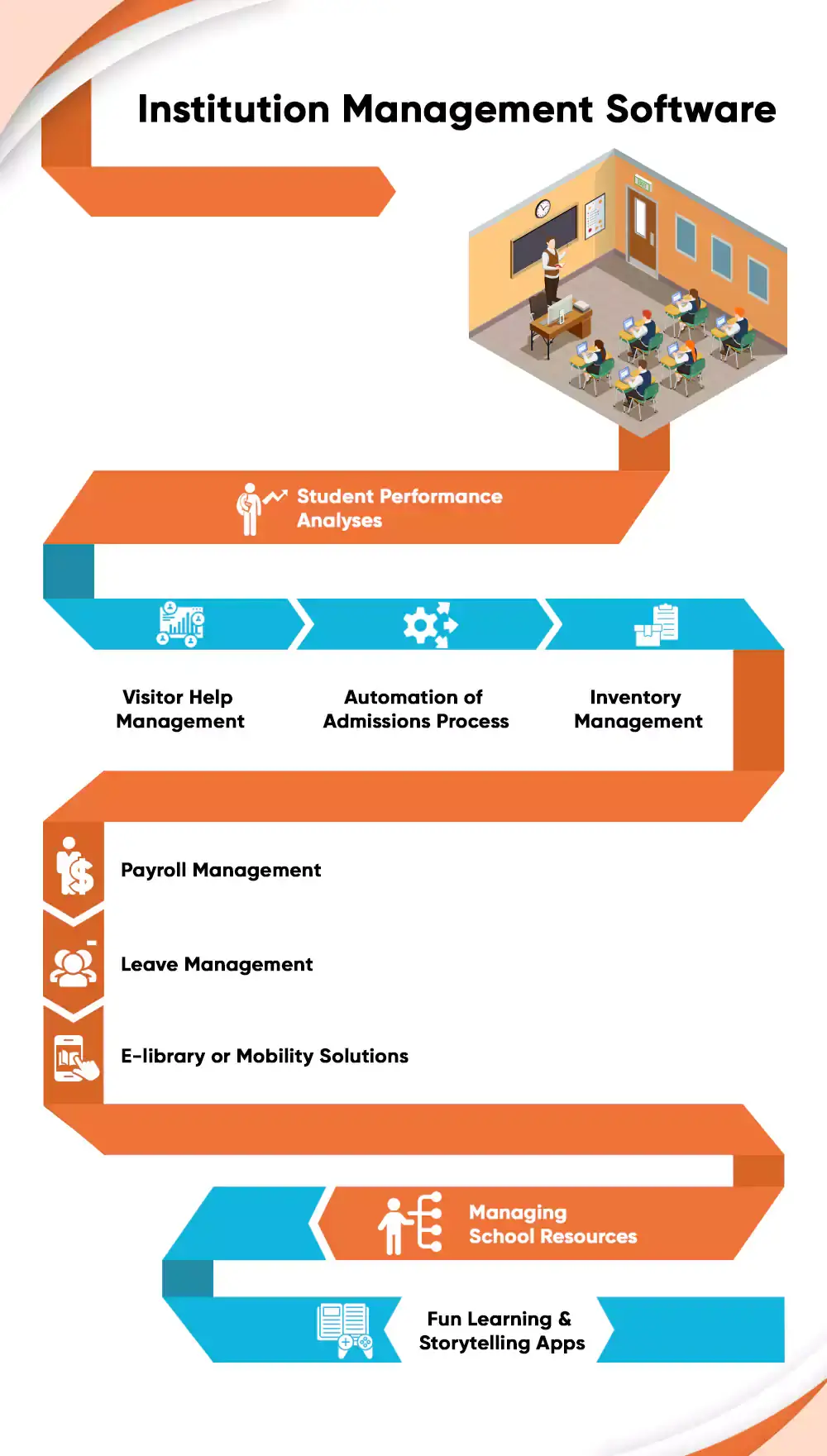
Designed for both teaching and administrative purposes, an institution management application considers some factors in institution administration that are often overlooked.
What are they? Let’s find out.
Student Performance Analyses
Like we mentioned before, the current conventional way of teaching does not consider the individual progress of a student. It is more designed towards collective goals and common causes. But education is never meant to be generic. It has to be as specific as possible. That’s what student performance analysis tools tend to achieve with their built-in artificial intelligence, machine learning and analytics tools and algorithms.
When implemented, these systems are capable of tracking the performance and progress of individual students, giving a detailed overview and insights on the strengths and weaknesses of students, recommending personalized learning paths, assessment papers, content suggestions, links to useful resources and more. As the student journeys in this system, the tools can also predict how the student would perform in the future with breakdowns of subjects or topics as well.
Visitor Help Management
Educational institutions are frequented by visitors of all types. From parents who intend to visit their children to guest speakers, lecturers and visiting professors, there is no dearth of visitors to institution premises. That’s why a visitor help management portal is absolutely inevitable as well.
With the help of this portal, visitors can register and check in to know more about the campus and understand navigation better. From an administrator perspective, this portal can help them assign security or assistance to escort key speakers or visitors inside the campus.
Such a portal also gives administrators an idea of the footfall of estimated visitors on a particular day and arrange for security as needed. This helps in securing an institution or a campus better. Need Help
Automation of Admissions Process
If you notice, the process of getting admission in an institute is a redundant process. The applicant fills the forms and does most of the tasks and intervention is required only for assistance and guidance. Management applications remove the presence of a human in the guiding process and replace them with bots and artificial intelligence systems that continue to guide applicants through the process and even help them successfully enrol to their preferred institutes and courses.
Inventory Management
An institute is a collective term for diverse modules such as libraries, hostels, placement cells, transportation system and more. In each of these modules, inventories of materials and assets (tech, paper-based, food and ingredients and more) used need to be maintained so that the associated processes in each bubble goes uninterrupted. With the help of inventory management tools, the process of tracking, monitoring and ordering institute materials can be automated along with the automatic initiation of processes like invoicing, payouts, real-time tracking of procurements and more.
Payroll Management
Administrators can save ample time in their work schedules through an efficient payroll management module in institution management systems. When payroll systems are integrated with biometrics-based attendance systems, corresponding salaries can be calculated and paid automatically to teachers and stakeholders. There is no need for manual intervention and reconciliation is as simple as sending a revisit request online. Through digitization of payroll, confidentiality can be maintained and the institute can pave the way for efficient and cost-effective systems to pay salaries.
Leave Management
Teachers and stakeholders can now seamlessly apply for leaves and requests through the institute management software. Modern-day solutions allow them to either select a preloaded reason or give their own reasons for absence and specify the duration of leaves for respective calculation of salaries. The portal takes care of reminding stakeholders about leave approval or rejection and brings in systems to carry forward pending leaves or offer options to encash them. The entire process can be automated as well.
Managing School Resources
Apparatus, computers, lab equipment and more constitute the resources in schools. And because they are part of school properties, they need to be tracked, monitored and maintained intact. That’s where school resources management portals or applications come into the picture. They help administrators keep a physical track of all resources in the premises and ensure they are maintained properly. In case of damages, these portals can help in replacement, fining and more.
E-library or Mobility Solutions
Institutes can offer their students digital versions of their libraries they could carry with them. This means that students could virtually rent eBooks and resources and use them on their portable or mobile devices. With an airtight intranet solution, these virtual libraries can also be limited in terms of their geographical access such as within the campus to avoid unauthorized access.
Fun Learning and Storytelling Apps
Exposure is what makes kids bright and intelligent and for that textbook knowledge and academic topics aren’t enough. They need to learn values and inculcate in them attributes that are required for the world. That’s what fun learning and storytelling apps do. Through interactive stories, videos, comics and more, these apps make learning fun an immersive, imparting newer knowledge and information to children for the betterment of their personal growth.
ERP for Institutes
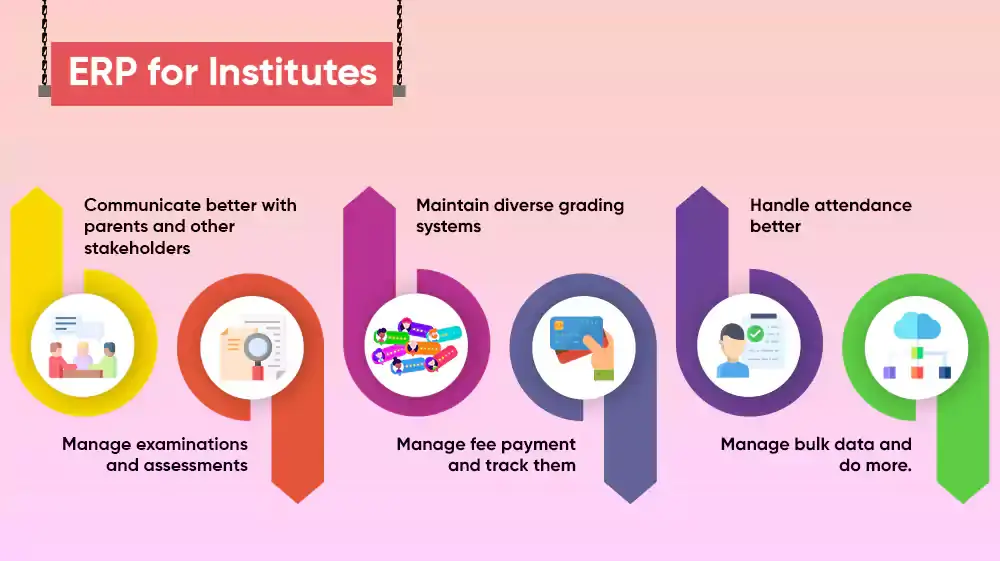
ERP stands for Enterprise Resource Planning. ERP software applications are the bridge between institutes and parents, giving them all the information, they need about their kids. Through an efficient ERP system, institutes can
- Communicate better with parents and other stakeholders
- Manage examinations and assessments
- Maintain diverse grading systems
- Manage fee payment and track them
- Handle attendance better
- Manage bulk data and do more.
Big Data Application in Institutes
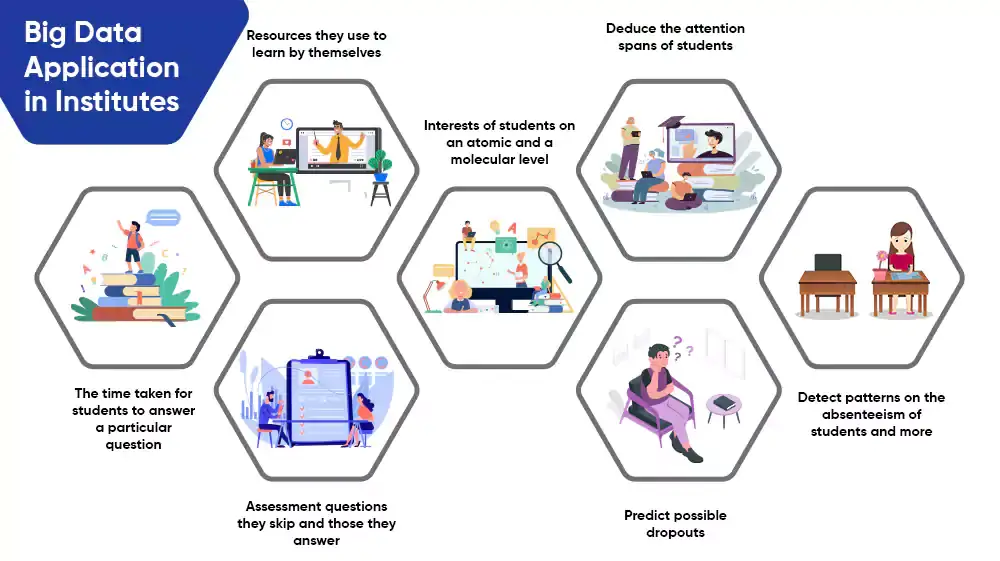
Big Data takes notice of everything a student does and more importantly what they don’t. More than the activities of students, crucial insights lie in their non-activities. In education, Big Data applications can be used to analyse
- The time taken for students to answer a particular question
- Resources they use to learn by themselves
- Assessment questions they skip and those they answer
- Interests of students on an atomic and a molecular level
- Deduce the attention spans of students
- Predict possible dropouts
- Detect patterns on the absenteeism of students and more
Case Study
One of the best examples of tech integration in education comes from HBMSU Smart Campus. Located in the United Arab Emirates, the smart campus is powered by ICT and is designed to optimize the learning and teaching experiences of students and faculty.
To give a quick example, the campus has implemented a responsive design to its technologies so regardless of the device students access the campus from, their experience is uniform in terms of navigation, screen size and user experience.
The smart campus also boasts of optimized social communication and collaborative learning. For this, the campus has introduced a feature called Shout Box, where students, staff, administrators or other stakeholders can ask questions on a wall and get responses in real time. From complaints to suggestions and ideas, everything is public on Shout Box.
Some of the key reasons why the university has set up a virtual campus include the need to foster an environment for creativity and critical thinking, achieve diversity in learning and teaching through digital tech, pave way for a learner-centric approach through active participation and responsible learning, to implement digital pedagogy and more.
Through the Smart Campus,
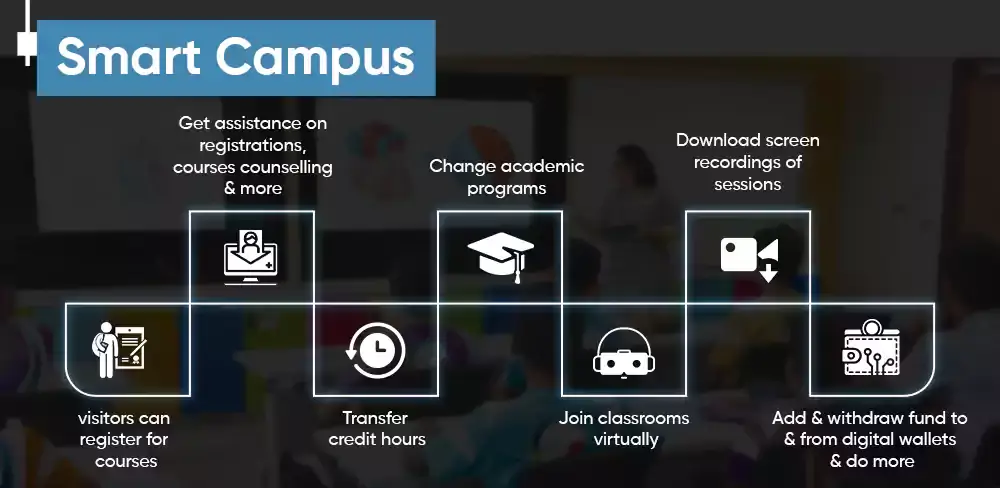
- visitors can register for courses
- Get assistance on registrations, courses counselling and more
- Transfer credit hours
- Change academic programs
- Join classrooms virtually
- Download screen recordings of sessions
- Add and withdraw fund to and from digital wallets and do more
With these implementations, the university was also able to increase its learner satisfaction levels to 87%. Truly, a remarkable implementation of technology for the betterment of all stakeholders involved. Need help
The Future of Technology in Education
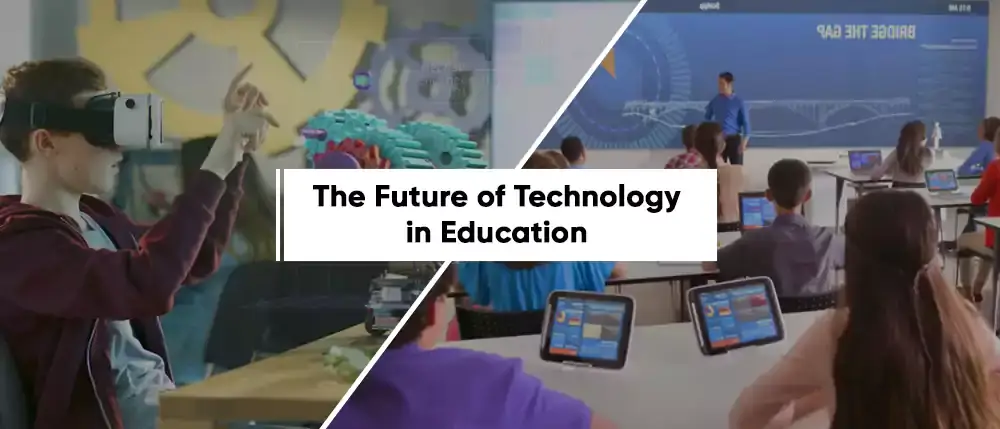
Edtech is already a futuristic ecosystem for a number of schools out there. But from the current perspective, it appears that edtech will continue to rule the education spectrum post the Covid-19 era. The pandemic has shown how inevitable edtech is and how gadgets and devices ensure perpetual learning and the future will only involve advanced systems in place for the optimization of teaching and management practices.
From our expertise, we envision a world where blockchain is implemented at school or institutional levels to ensure tamper-proof maintenance of crucial records and data. Blockchain will also make assessment and evaluations simpler and in real time.
Concepts like augmented reality and virtual reality will become mainstream in the education sector. These will offer a more immersive learning experience to students as they can watch food getting digested in real time through visuals for maximum retention. They can also witness incidents like the Boston Tea Party from their own perspectives.
Eye trackers would be installed in classrooms to understand student behaviour and interests better. Through heatmap technologies, teachers and stakeholders can deduce the attention spans of students, identify when students are zoning out, when they are distracted and more and rectify teaching methodologies and content. Eye trackers can be used for attendance as well.
Artificial intelligence will continue to dominate the learning space through advanced recommendation engines, student performance analyses, predictive analyses and more.
Flexible displays will become a norm and institutes might do away with conventional notebooks and go completely digital through tablets, laptops and other mediums.
Gamification will reach the grassroot levels around the world, where institutes in remote regions will implement gamification techniques to prevent dropouts and optimize learning.
Wrapping Up
So, these were some of the challenges prevailing in the education spectrum and their solutions. If you think, all the major challenges can be overcome through simple tech implementations like ERP systems, institute management software or educational platforms.
The learning curve in these are minimal and take very less time for deployment as well. If you intend to get one installed at your institute or want to get a tailor-made platform developed for your school, reach out to us.
We will design and launch a portal or an application that meets your academic goals and ensures your students achieve nothing less than excellence.
Get in touch with us today.